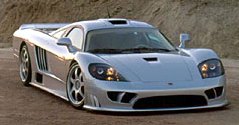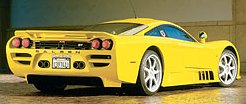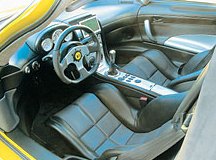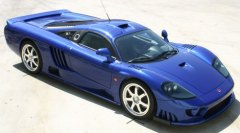 Forgive
me if you are American, but I have to say this: American never know how
to build supercars. Their so-called supercars are usually modified
Corvettes
and Mustangs or some never-takeoff dream machines, such as Vector. Why?
because compare with Europe, America is lack of a suitable environment
to breed supercars - it doesn’t have any established sports car makers
like Ferrari and Porsche. It lacks high-tech motor racing such as
Formula
One and World Rally to train up engineers. It lacks suppliers of
high-tech
components that you can easily find in Italy and UK. That’s why the
best-ever
American supercar, Ford GT40, was actually engineered by Lola in UK. Forgive
me if you are American, but I have to say this: American never know how
to build supercars. Their so-called supercars are usually modified
Corvettes
and Mustangs or some never-takeoff dream machines, such as Vector. Why?
because compare with Europe, America is lack of a suitable environment
to breed supercars - it doesn’t have any established sports car makers
like Ferrari and Porsche. It lacks high-tech motor racing such as
Formula
One and World Rally to train up engineers. It lacks suppliers of
high-tech
components that you can easily find in Italy and UK. That’s why the
best-ever
American supercar, Ford GT40, was actually engineered by Lola in UK.
However, is it really impossible to build a financially viable supercar in America? Steve Saleen thinks not. Saleen is an established American car tuner renowned for converting Ford Mustang. 3 years ago, it started making a clean-sheet mid-engined supercar for competing in American GT series. That’s the S7R. It won 19 races in 2001, including the Sebring 12 Hours. A clause in the regulation required Saleen to build some road cars. Delay after delay, the first road car was finally delivered to customer recently. Some car magazines were invited to test the production car and none of them finished the day without impressed by its strong performance. Compare with the contemporary European supercars such as Pagani Zonda, Ferrari Enzo, Porsche Carrera GT, McLaren Mercedes SLR and Bugatti Veyron, this American supercar is designed and constructed more like a GT racing car than a road car. It is very wide, low and long. It has massive skirts and ground effect diffuser to generate as much as 1300kg of downforce at 160mph. It employs a classic mid-engined, rear-drive layout, suspended by double-wishbones all round via racing-style adjustable dampers without any electronic aids - no adaptive damping, no traction control, no stability control and not even ABS. Also like a racing car, ground clearance is almost non-existent while the lack of suspension travel results in a super-stiff ride that could easily rock you eyeballs off. But racing technologies are not necessarily edge-cutting. Just like the famous Dauer 962LM, you won’t say it more sophisticated than a contemporary McLaren F1, would you? to Saleen S7, evidence can be found in its chassis. While all other serious supercars employ a chassis made of either carbon-fiber monocoque or carbon-fiber tub, the S7 still relies on a tubular steel spaceframe, just like a Dauer 962LM, or to insult it, a Lotus Seven of 1957. Needless to explain, this chassis comes no where near its rivals in terms of weight and rigidity. Now you understand why Saleen has to tune its suspensions so hard.
Another problem is engine. Apparently, Saleen cannot afford to build a powerful engine from ground up and it has to source from somewhere. However, in America it cannot find stock engines as good as Pagani’s AMG 7.3-litre V12. Therefore it decided to take a NASCAR Ford V8 and thoroughly re-engineered it. The 7.0-litre unit remains a push-rod 2-valve-per-cylinder design, perhaps quite laughable to European supercar engineers. Steve Saleen defended, “What kind of American supercar would it be if it didn’t have a pushrod V-8?” he just didn’t tell you why American never build good supercars. For the same reason, I guess. However, Saleen cast its own aluminum block and heads to save weight, then installed a forged steel crankshaft to cope with its 550 horsepower at 5900rpm and 525 lbft at 4000rpm. This is a torquey engine, although not as torquey as Pagani’s mega V12. As the S7 is relatively simple compare with other contemporary supercars, it weighs just 1300kg, heavier than Pagani by 50kg but lighter than Enzo by 65kg. Therefore it makes very good use of the horsepower. Car And Driver found it took just 3.3 second to accelerate from zero to 60mph, almost matching the all-time record of 3.2 sec set by McLaren F1 ten years ago. This is already enough to level with Ferrari Enzo. But note that the Saleen is geared to reach 60mph in 1st gear, without any gearchange, probably intended to achieve a 0-60 figure to attract public attention. To see its real ability, 0-100mph is more useful - now it takes 7.6 second, a massive 1.0 second behind the Enzo and even slower than Pagani by 0.2 second. As for top speed, Saleen claims a wild 223mph. It looks unlikely for a 550-horsepower-only supercar with so large frontal area and undisclosed drag coefficient. The company declared it as the most aerodynamically efficient street car in the world, thanks to the hard work taken in the wind tunnel of the University of Glasgow in Scotland (another non-American content). Nevertheless, I doubt whether its downforce-biased shape could achieve low drag simultaneously. For your information, both Porsche Carrera GT and Mercedes SLR claimed lower top speed than the Saleen despite of their 600-plus horsepower output.
Not only the cockpit, but all the controls work like a race car's - the clutch is heavy and difficult to engage. Launching the car without stalling its engine takes a good skill and some practice. The gearshift of the 6-speed manual gearbox is solid - Porsche and Ferrari will never approve such a transmission. The steering, with just 2.0 turns from lock to lock, is sharp and accurate. On the road, the Saleen S7 also drives like a racing car. On the right surface, you will appreciate its stability, downforce and the lack of body roll. But it rides so harsh that only glass-smooth race tracks can exploit its potential. Every small dip and bump on the road surface is an enemy to the S7 and its occupants. The vibration, the shake, the noise and the steering kick-back show how raw, how unpolished and how uncompromising the Saleen is. What about the push-rod V8 ? well, it may be the most powerful naturally-aspirated V8 in the world, but how can it compete with rivals' V10 and V12s, which are more willing to rev, generate better noise and deliver more horsepower? When you pay as
much as US$400,000,
you certainly deserve a better car than this one. A Pagani Zonda could
be the answer. |
| The above report was last updated on 7 July 2003. All Rights Reserved. |
 To
compensate, the body is made of carbon-fiber, or
carbon-fiber-reinforced
aluminum honeycomb sandwich at where extra stiffness is required.
However,
Saleen found no where in the America can build these sophisticated
parts
thus it has to outsource from UK.
To
compensate, the body is made of carbon-fiber, or
carbon-fiber-reinforced
aluminum honeycomb sandwich at where extra stiffness is required.
However,
Saleen found no where in the America can build these sophisticated
parts
thus it has to outsource from UK.  The
cabin of S7 is not a piece of art. Although it has a price tag matching
Pagani Zonda, its cockpit is full of Ford switch gears and low-rent
materials.
On the positive side, equipment level is generous - air-conditioning,
power
windows, central locking and a LCD screen showing the rear view from a
video camera. Driving position is similar to a race car's - the cockpit
is narrow, the footwell is very tight, the pedals are seriously offset
towards the center, the carbon-fiber seats are non-adjustable. Luckily,
the driving position is fundamentally good, as Saleen will tailor-set
the
position of pedals for each client.
The
cabin of S7 is not a piece of art. Although it has a price tag matching
Pagani Zonda, its cockpit is full of Ford switch gears and low-rent
materials.
On the positive side, equipment level is generous - air-conditioning,
power
windows, central locking and a LCD screen showing the rear view from a
video camera. Driving position is similar to a race car's - the cockpit
is narrow, the footwell is very tight, the pedals are seriously offset
towards the center, the carbon-fiber seats are non-adjustable. Luckily,
the driving position is fundamentally good, as Saleen will tailor-set
the
position of pedals for each client.  Saleen
S7 might have very high exposure in American magazines and websites,
but so far it is yet to get recognition from the world. People paying
US$400,000 are likely to expect more than a race-converted-to-road car.
They want a prestige brand name, an exotic design, a high quality
finishing and spectacular performance. Unfortunately, the original S7
had none of these qualities. That's why it needed to upgrade the S7 to
S7 Twin-turbo.
Saleen
S7 might have very high exposure in American magazines and websites,
but so far it is yet to get recognition from the world. People paying
US$400,000 are likely to expect more than a race-converted-to-road car.
They want a prestige brand name, an exotic design, a high quality
finishing and spectacular performance. Unfortunately, the original S7
had none of these qualities. That's why it needed to upgrade the S7 to
S7 Twin-turbo.